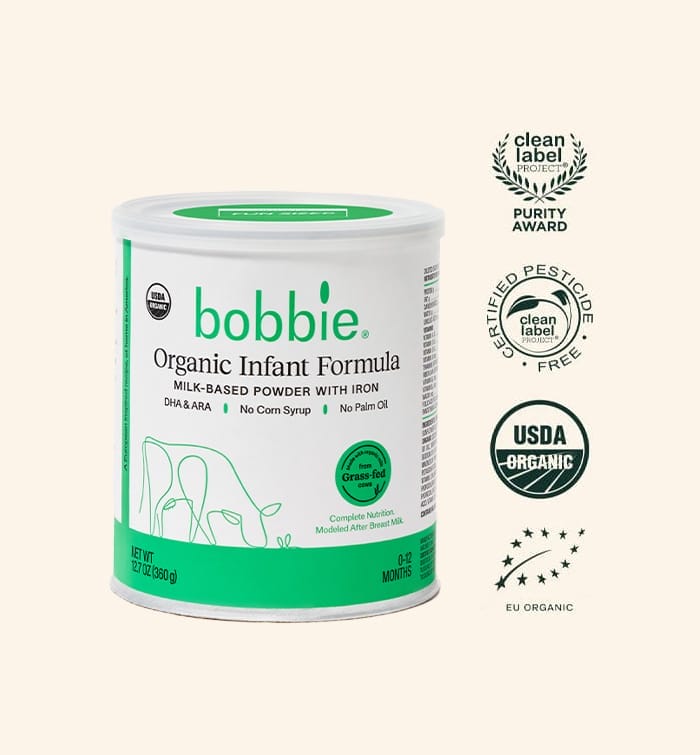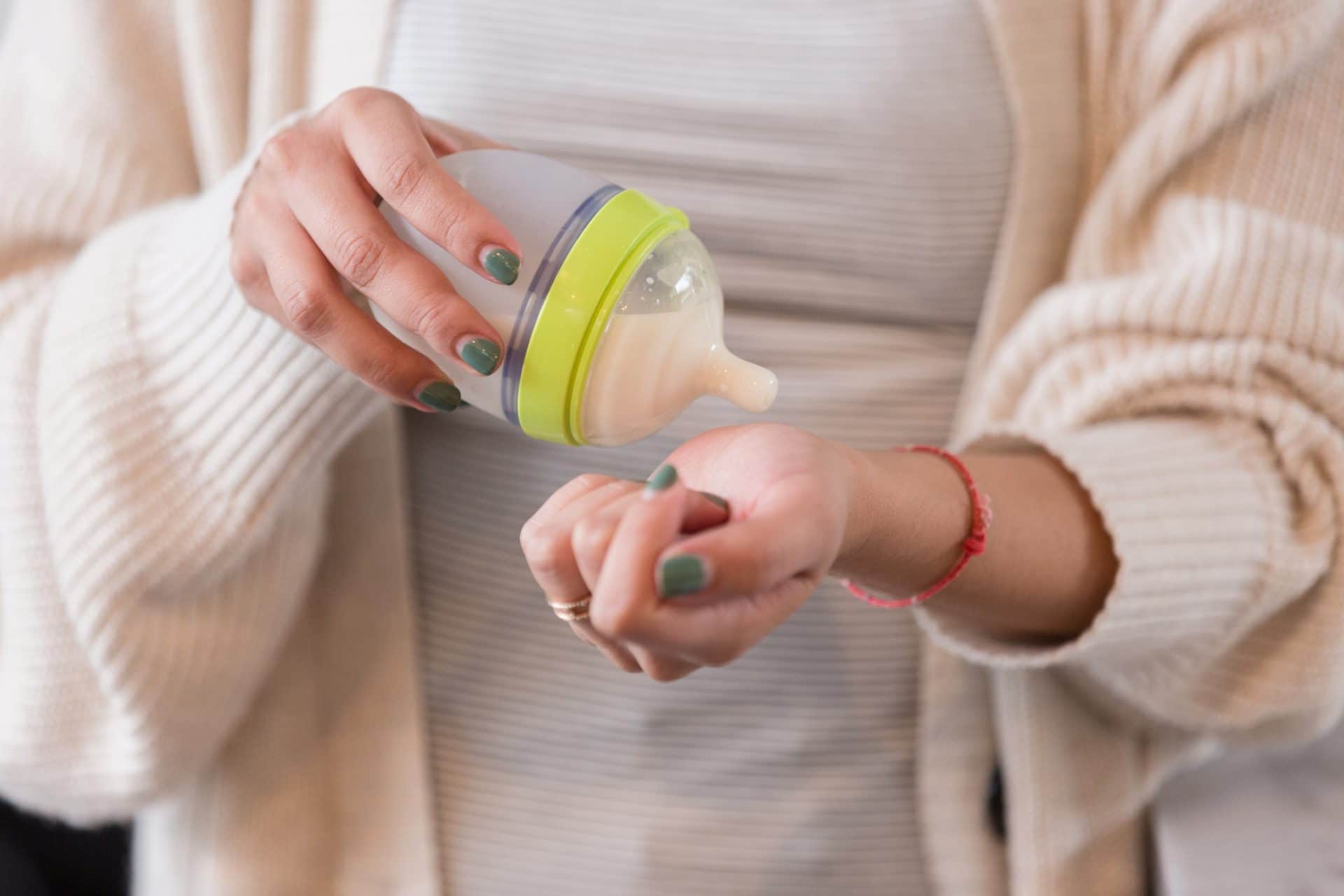We are proud to say that these posts are not sponsored. Our editorial team of Bobbie moms and writers personally select each featured product. If you buy something through our links, we may earn an affiliate commission, at no cost to you.
Parents often wonder if their baby’s bottles need to be warmed up before serving. Just like adults, some babies prefer warm to cold. If you’ve been wondering can babies drink cold formula or does baby formula have to be warm— we’ve got your answers on all things related to the best temperature of infant formula.
- How to prepare a baby formula bottle
- Should you use warm or cold water to make infant formula bottles?
- What type of water can you use to make a baby bottle?
- How to boil water for a baby bottle
- Do I need to warm a cold bottle before giving it to my baby?
- Can you use a microwave to heat a baby bottle?
- What to know about bottle temperature and baby bottles
How to prepare a baby formula bottle
Don’t forget that there are a few steps to bottle preparation you need to complete before mixing the water and formula.
Sterilize baby bottles and other feeding items
For most babies, sterilizing bottles only needs to be done before the first time you use the bottle. However, if your baby was born prematurely or has medical issues, it’s a good idea to ask their healthcare provider if you should be sterilizing bottles more often.
Bottles and feeding items can be sterilized using the dishwasher sanitizing setting, by boiling them in water, using a bottle sanitizing steam machine or cleaning them with a bleach solution if none of these other options are available.¹
Clean the area where you’ll be making the baby bottle
Just like you want your feeding items to be as clean as possible, you also want the area where you’ll be making the bottle to be clean. This way germs can’t make their way into the bottle from the surrounding area.
Wash your hands before preparing a baby bottle
You probably already knew this one, but any step is easy to forget in the middle of the night (or the middle of the day for a sleep-deprived new parent!). Wash your hands thoroughly with soap and water and dry them with clean or disposable cloth.²
Read the instructions for your baby formula
Anytime you are using a brand or type of formula for the first time, be sure to read the instructions to make sure you’re using the right amount of water and following any other formula manufacturer recommendations.³
And while you’re at it, use a marker to write the date you opened the container on the outside of the lid so you can be sure not to keep it longer than recommended.

Shop Bobbie Organic Infant Formula
Bobbie Organic Infant Formula is a USDA Organic, EU-style infant formula that meets all FDA requirements. It is a complete nutrition milk-based powder modeled after breast milk and is easy on tummies. It is non-GMO and doesn't have corn syrup, palm oil, or maltodextrin. Learn more about Bobbie.
Should you use warm or cold water to make infant formula bottles?
Before getting to temperature, let’s talk water safety. Do you need to boil your water?
Whether or not you need to boil your water before making a baby bottle depends on a few factors. First, you need to know about the safety of your tap water. If you’re not sure about this, you can contact your local health department.
Whether or not you need to boil your water also depends on your baby’s health needs. Some babies- like those that are very young, were born prematurely or have medical issues- may need formula made from boiled water.³
Be sure to check with your baby’s healthcare provider to see if you need to use boiled water or not.
What type of water can you use to make a baby bottle?
You can use tap water for infant formula, if your water source is safe. We share the specifics on if you can use tap water, bottled water or well water in this best water for formula story.
How to boil water for a baby bottle²
- Bring water to a rolling boil
- Allow the water to cool for about 30 minutes (to no less than 158℉/70℃)
- Pour the amount of water needed into the bottle first
- Add the correct amount of formula powder using a full, level scoop⁴
- Shake the bottle
- Cool the bottle to feeding temperature by running it under cold water or putting it in a bowl of ice (be sure not to let unboiled water touch the nipple!)
- Test a few drops of formula on your wrist before giving it to your baby to make sure it’s not too hot
Do I need to warm a cold bottle before giving it to my baby?
Whether you are making a bottle with cold tap or bottled water or using one you’ve made in advance and stored in the fridge, parents frequently ask if they need to warm it up before giving it to their baby.
In short, the answer is no. There is no medical reason to heat a bottle, it’s just a choice that some parents make. If your baby likes a cold bottle, great! This can save you a step in the feeding process and make life a little easier.
If you do want to warm your baby’s bottle, you have a few options:⁵
- Run the bottle under hot running tap water for a few minutes
- Heat up a bowl or pan of water and place the bottle in it. (Just don’t put the bottle in a bowl or pan while it’s still on the stove)
- Use a bottle warmer machine made just for this purpose
Just like making a bottle from boiled water, be sure to test a few drops on your wrist before giving it to your baby.
Can you use a microwave to heat a baby bottle?
NEVER heat a baby bottle in the microwave. Microwaves don’t heat things evenly, which can lead to hot spots that can burn your baby’s mouth.
What to know about bottle temperature and baby bottles
Whether or not you need to boil the water you’ll be using to make your baby’s bottle depends on a few factors, so it’s best to talk this over with your baby’s healthcare provider to figure out what’s best for your baby.
The decision to feed your baby a cold or warm bottle is really more about your preference (or more likely your baby’s preference!). If you do choose to heat a bottle, make sure you do it safely and always test the temperature before giving it to your baby.

Shop Bobbie Organic Infant Formula
Bobbie Organic Infant Formula is a USDA Organic, EU-style infant formula that meets all FDA requirements. It is a complete nutrition milk-based powder modeled after breast milk and is easy on tummies. It is non-GMO and doesn't have corn syrup, palm oil, or maltodextrin. Learn more about Bobbie.
Sources:
1- How to clean, sanitize, and store infant feeding items | Centers for Disease Control and Prevention
2- How to prepare formula for bottle-feeding at home | World Health Organization
3- Infant formula preparation and storage | Centers for Disease Control and Prevention
4- Feeding your infant: how to prepare and store baby formula | Cleveland Clinic
5- Formula feeding FAQs: preparation and storage | Nemours Kids Health

